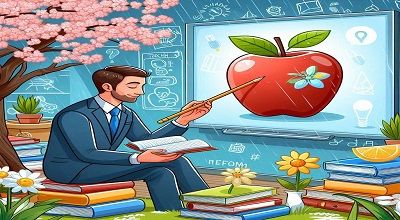Refining Your Teaching Practice
Refining your teaching practice with springtime reflection can be a valuable process for educators to assess their teaching methods, make improvements, and finish the school year strong. Here are some steps to help you get started:
Review Your Goals and Objectives:
Revisit the learning objectives and goals you set at the beginning of the school year or semester. Are your students on track to meet these goals? Have any adjustments become necessary?
Assess Student Progress:
Analyze the data, assessments, and assignments from the school year so far. Are there any trends or patterns in student performance that you can identify? Are there any areas where students may need additional support or challenges?
Gather Feedback:
Solicit feedback from your students through surveys or class discussions. Ask them about what’s working well in the classroom and what could be improved. This feedback can provide valuable insights into their learning experiences.
Self-Reflection:
Reflect on your teaching methods and practices. Consider what has been effective and what hasn’t. Are there specific teaching strategies, resources, or techniques that you’ve found particularly successful or challenging?
Classroom Environment:
Evaluate the physical and emotional classroom environment. Is it conducive to learning and student engagement? Are there any adjustments you can make to enhance the atmosphere?
Professional Development:
Identify areas where you’d like to grow as an educator. Are there specific teaching skills or knowledge areas you’d like to improve? Consider attending workshops, and conferences, or seeking out additional training to enhance your teaching practice.
Curriculum and Materials:
Review the curriculum materials you’ve used so far. Are they still effective, or do you need to update them? Are there any new resources or materials you could introduce to enhance your teaching?
Collaboration:
Reach out to colleagues and engage in professional conversations. Share your experiences and insights with other educators. They may have suggestions or solutions to challenges you’ve encountered.
Set Goals for the Rest of the Year:
Based on your reflections and feedback, set clear, achievable goals for the remaining part of the school year. Ensure these goals align with your initial objectives and address any identified areas for improvement.
Implement Changes:
Make the necessary adjustments in your teaching methods, materials, and classroom environment to address the insights gained from your reflection process. Continuously monitor and assess the impact of these changes on student learning.
Celebrate Achievements:
Acknowledge and celebrate the successes and progress you and your students have made throughout the year. This can boost motivation and create a positive atmosphere in the classroom.
Document Your Reflection:
Keep a journal or record of your reflections, changes made, and outcomes. This will be valuable for future reference and can help you refine your teaching practice in subsequent years.
Summary
Springtime reflection can help you adapt your teaching methods and improve your effectiveness as an educator. By regularly assessing your teaching practice and making adjustments as needed, you can create a more engaging and effective learning experience for your students.
